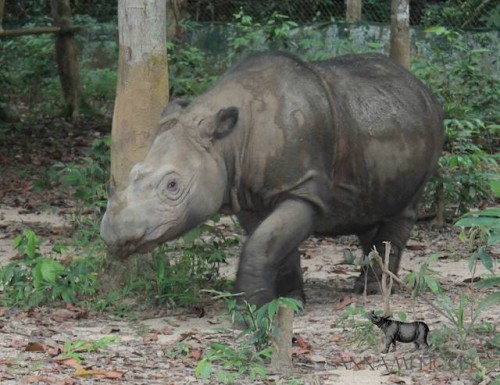
Solidarity: The five Asian rhino range states of Bhutan, India, Indonesia, Malaysia, and Nepal are standing firmly behind the international ban on rhino horn trade.
But first, a bit of historical perspective on Asian rhinos.
Asia is home to three of the five rhino species — the greater one-horned, Javan, and Sumatran rhino. The most ancient rhino species is in fact, the Sumatran rhino, who still sports a coarse coat of hair reminiscent of its prehistoric predecessor, the woolly rhinoceros. And with the combined population of Asian rhinos at less than 4,000, the region is all too familiar with the devastation wrought by rhino horn trade.
These three species once inhabited an impressive range. Greater one-horned rhinos roamed the Indian subcontinent from Pakistan to perhaps southern China and Myanmar. Javan and Sumatran rhinos were even more widespread. Comprised of three subspecies each, these rhinos were found from northeastern India through southern China, including Bangladesh, Cambodia, Laos, Malaysia, Thailand, and Vietnam. The Javan rhino’s range extended to Myanmar, and the Sumatran’s range encompassed Bhutan and Brunei.
Fast forward to today, and we see what happened to the rhinos who were unfortunate enough to exist in close proximity to the largest traditional Chinese medicine consumer base in the world. Add to that China’s rhino horn carving industry, rampant “sport” hunting throughout the 1800s and early 1900s (the greater one-horned and Javan rhinos are about the same size as Africa’s white and black rhinos respectively), along with continued unchecked habitat destruction for palm oil production — and it is a wonder there are any Asian rhinos left anywhere.
VIDEO: “Ancient Rhinos of Southeast Asia – By A Thread”
The greater one-horned rhino is indeed a shining example of successful conservation efforts. From fewer than 200 individuals in the early 20th century, this species now numbers approximately 3,333 in protected areas of India and Nepal. And although there are fewer than 50 Javan (two of three subspecies are extinct) rhinos and less than 100 Sumatran (one subspecies is extinct) rhinos — with viable populations restricted to Indonesia — conservation gains are steadily being made with these species. Javan rhino habitat has recently been expanded and there is now evidence of rhinos utilizing the new area. The 2012 birth of Sumatran rhino Andatu to the unique pairing of Cincinnati Zoo-born Andalas with wild Ratu signaled significant progress in the reproductive husbandry of this comparatively little-known rhino species.
Which brings us back to the five Asian rhino range states’ position regarding the international rhino horn trade ban.
In October 2013, the governments of Bhutan, India, Indonesia, Malaysia, and Nepal convened in Bandar Lampung (Indonesia) for the first-ever Asian Rhino Range States Meeting. Addressing both the successes of greater one-horned rhino recovery efforts and the urgency of implementing sound Javan and Sumatran rhino conservation plans, the five governments committed to “achieving at least 3% annual growth rate in their populations” by signing the historical Bandar Lampug Declaration.
Maintaining populations and preventing extinction is not enough. The aim is to bring about the recovery of these species.
Noting that “pressure from illegal hunting on all species of rhinos has grown seriously in recent years, linked to a significant increase in non‐traditional use of rhino horn and a significant rise in the price of rhino horn in Asian markets, especially in Vietnam and China”, the signatories agree that trade in “all rhino products” must remain internationally banned.
The CITES ban in the international trade of all rhino products needs to be maintained and enforced, including by those countries where rhino products are used, any countries that act as intermediate points in the trade, and all rhino range states.
The Declaration also urges the use of INTERPOL Red Notices for wildlife trafficking suspects who are operating internationally. Nepal has already done so, requesting that a Red Notice be issued for Rajkumar Praja, a Nepalese national wanted for killing rhinos and international rhino horn trading.
But here’s why reaffirming the commitment to uphold the international ban on rhino horn trade is critical.
The South African government currently favors decided against a proposal to lift the international ban on rhino horn trade. What needs to be understood by both the media and the public is that this position stands to enrich just a handful of ranchers who actually own rhinos under South Africa’s privatized “wildlife conservation” system (unsurprisingly, these individuals are the loudest advocates for the rhino horn trading scheme).
*** Update: Swaziland Submits Rhino Horn Proposal for CoP17 ***
In other words, South Africa’s argument (“Rhino Horn: Debunking the Pro-Trade Propaganda“) favors only South Africa’s privatized rhino industry, not its wild rhinos. And certainly not wild rhinos in Asia — or any other range state.
Determining the future of wild rhinos is not the responsibility — nor is it the right — of just one country. Bhutan, India, Indonesia, Malaysia, and Nepal have taken the lead by joining together and collectively reaffirming their commitment to the international ban on rhino horn trade.
Who’s next?




